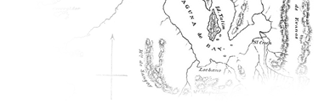

 |
 |
|
  |
|
About the U.S. Exploring Expedition Artifact Database The catalogue of the U.S. Exploring Expedition's collection of ethnographic and archaeological artifacts amassed during the four-year voyage was compiled in the 1840s by two members of the scientific corps, Titian Ramsay Peale and Charles Pickering. The original catalogue "Collections of the United States South Sea Surveying and Exploring Expedition," which can be found in the National Anthropological Archives, lists 2,487 artifacts with 29 duplicate numbers, for a total of 2,516 ethnological specimens. The collection documents most of the world they explored, including North and South America, Asia, Australia, New Zealand, Hawaii, Samoa, Tonga and Fiji and numerous other Pacific island groups. The collection was exhibited in the Great Hall of the Patent Office until 1857 when it was transferred by order of the United States Congress to the Smithsonian Institution. One result of this transfer was the establishment of the United States National Museum. Today, the specimens, which were often called "curiosities" when they were first collected, are part of the collections of the Department of Anthropology, and are the earliest and, in some cases, rarest and most important objects the Institution possesses. This database, which can now be accessed for the first time by the public, is a somewhat improved version of the original Peale catalogue. It lists each object with its Smithsonian catalogue number, its original, or Peale catalogue number, its collector, whether a member of the scientific corps, an officer or regular crew member, a physical description of the object, and information about its exhibition, research and publication history. The last category is meant to give details about what has happened to the object since its transfer to the Smithsonian. Despite the fact that these artifacts are indeed some of the earliest and most important in the Smithsonian's collection, more than 500 of the original 2,500 artifacts were given away. Spencer Baird, following James Smithson's original mandate to increase and diffuse knowledge, diffused the collections by giving away sets of U.S. Exploring Expedition objects, which he viewed as "duplicates," starting in 1859. Continuing this trend, In 1867, he had 25 U.S. Exploring Expedition museum starter kits made up and sent them to state collections of natural history, colleges and universities in the United States, Canada and Europe. Eventually, these artifacts found their way to more than forty museums in North America and Europe. Unfortunately, some exchanged objects met with disaster during the 19th century. For example, a set sent to Amherst College and one to the University of Toronto disappeared when the buildings in which they were housed burnt down. One of the largest collections of U.S. Exploring Expedition material, more than fifty artifacts, went to the Chicago Academy of Science in 1867, and was consumed in the great Chicago fire in 1872. Happily, most of the objects held in the Smithsonian Institution have survived. Jane
Walsh January 2004 |